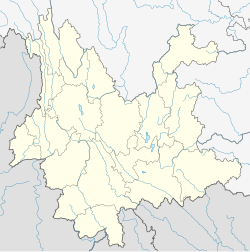1913 Eshan earthquake
| UTC time | 1913-12-21 15:37:56 |
|---|---|
| ISC event | 914108 |
| USGS-ANSS | ComCat |
| Local date | 21 December 1913 |
| Magnitude | Mw 6.8 |
| Depth | 15 km (9 mi) |
| Epicenter | 24°15′50″N 102°49′37″E / 24.264°N 102.827°E |
| Type | Strike-slip |
| Areas affected | Yunnan, China |
| Max. intensity | MMI IX (Violent) |
| Casualties | 942–1,900 fatalities |
The 1913 Eshan earthquake struck China's
Tectonic setting
Major earthquakes in eastern Yunnan and the border with Sichuan are associated with the north–south striking Xiaojiang Fault; the west–northwest striking Zemuhe Fault to its north; and the northwest trending Qujiang–Shiping Fault. Some of these faults, including the Red River Fault, represent the boundaries of tectonic blocks within both provinces. The Qujiang–Shiping Fault comprises two fault segments (north and south) with a total length of 120 km (75 mi) that strikes northwest to west–northwest and eventually east–west at its southern part. Its slip mechanism comprises right-lateral strike-slip with a notable thrust component. The region is one of the most seismically active zone in Yunnan.[2]
Earthquake
The Qujiang Fault runs northeast and parallel to the much longer Red River Fault, striking northwest–west-northwest. Three ≥M7.0 earthquakes, including the 1913 earthquake, occurred on this fault in 1599 and 1970. The 1970 earthquake measuring Ms 7.7 caused a 60 km (37 mi) surface rupture.[3] The northwestern Qujiang Fault ruptured during the 1913 earthquake while its southeastern portion was associated with the earthquake in 1970.[4]
Impact
More than 18,000 homes were destroyed and the earthquake affected a 3,000 km2 (1,200 sq mi) area. When the earthquake struck, the region was experiencing heavy snowfall which caused many survivors to die from freezing and starvation. A plague further added to the suffering on top of the lack of food and clothes. Looting was also taking place.
See also
References
- ^ ISC (27 June 2022), ISC-GEM Global Instrumental Earthquake Catalogue (1900–2009), Version 9.1, International Seismological Centre
- S2CID 131667346.
- .
- S2CID 213502598.
- ^ Sichuan Provincial Seismological Bureau (21 December 2021). "民国时期云南死亡超千人的地震,诞生我国第一篇地震专题考察报告" [An earthquake in Yunnan that killed more than 1,000 people during the Republic of China produced my country's first special earthquake investigation report]. Sohu (in Chinese). Retrieved 23 December 2023.
- doi:10.7289/V5TD9V7K.
- .

